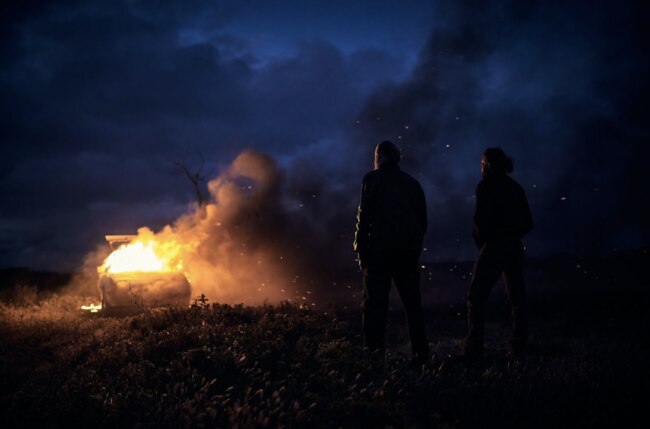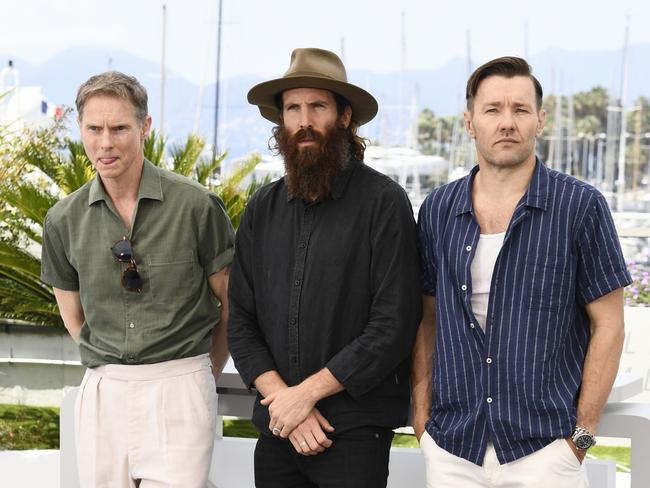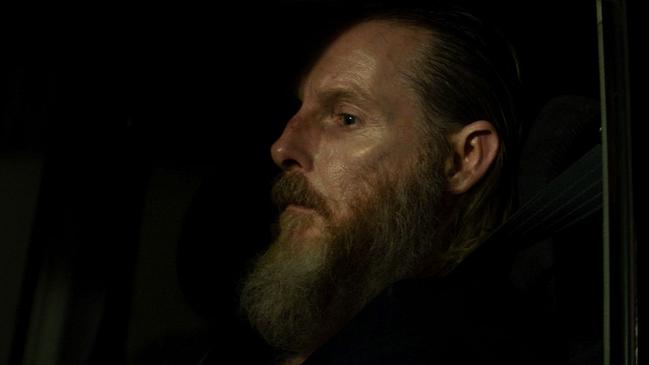Why Thomas M. Wright is one to watch
The Stranger attracted the kind of critical attention usually reserved for the mainstream attractions at Cannes Film Festival.

The Stranger premiered in the Un Certain Regard section of the Cannes Film Festival – a part of the competition devoted to arthouse films that rarely garners much fanfare.
Yet during its outing in France this month, the second feature from 38-year-old Melbourne-born filmmaker Thomas M. Wright, whose first film was 2018’s Acute Misfortune and who has acted in TV and film including Warwick Thornton’s Sweet Country, attracted the kind of critical attention – and a standing ovation – usually reserved for the festival’s mainstream attractions.
In part, this can be attributed to the stars, Joel Edgerton and revered Brit Sean Harris, and the backing of Oscar-winning producers See Saw films (The King’s Speech, The Power of the Dog).
But it is also a sign that Wright is a talent to watch, who wrought from his two leads riveting performances on a meticulously shot canvas described as “otherworldly” by some and “bleak” and “disturbing” by others.
The film, we are told, is inspired by a true story and we watch as police officers search the grass beneath a bridge for clues.

We meet Edgerton’s Mark, who presents as a crook, part of a vast crime organisation, with his wraparound sunglasses, sporting a ponytail and bushy beard. Mark wants to enlist Harris’s similarly bearded, pony-tailed Henry for a job that will pay $100,000. “I don’t do violence,” declares an obviously worn-down Henry. Then it transpires that Mark is an undercover detective out to elicit a confession to the murder of a 12-year-old boy.
The story is a fictionalised retelling of the 2003 murder Daniel Morcombe, who disappeared from a Sunshine Coast bus stop when he was 13 years old.
The film was shot in South Australia on Panavision C series anamorphic lenses (those used in Paul Thomas Anderson’s There Will be Blood) after a period of in-depth research on the psychology of undercover detectives.
Wright, whose TV and film roles have also included Rob Connelly’s Balibo, Jane Campion’s Top of the Lake, and Baltasar Kormákur’s blockbuster Everest, began his career on the stage; co-founding the anarchic Black Lung Theatre and Whaling Firm fringe theatre troupe in Melbourne.
As a director, says Edgerton, Wright has “a certain robust, kind of no-nonsense poetry about the way he thinks and the way he sees the world”.
Reviews of The Stranger out of Cannes reference classics Walkabout and Picnic at Hanging Rock, binding it to the Australian traditions of storytelling on film.
In this Q&A, Wright ponders a personal, professional and existential experience – from making The Stranger to its prestigious premiere.
Your first film was 2018’s Acute Misfortune. Why did you choose this story as your second film?
I was afraid of it. It’s unlike anything in the genre – and I was compelled to find a form to be able to deal with it – the scale of the narrative, of the investigation and operation, and the personal, psychological side of that … It was also an opportunity to reconcile mistakes made and lessons learnt on my first film – and an to follow certain threads of that film.
With Acute Misfortune (based on Erik Jensen’s novel about his relationship with artist Adam Cullen), I made a film about how individuals are formed by family, society and culture – taught what to want, and how to be. The Stranger is dealing with more primal aspects – the human capacity for violence – and need for order. If Acute Misfortune was a film about a relationship based on theft, The Stranger is a film about a relationship based on lies.
Walkabout was mentioned in one review of The Stranger. What aspects of Australian cinema influenced the film?
The Stranger is a far more traditional film than Walkabout. Perhaps they’re talking about the burning car … Walkabout holds a lot of contradictions, though. For the white characters, it’s about estrangement to place. That’s a central theme of our national cinema and of our visual art and literature. This country has been defined by hidden violence – and we’re conscious of that, we can feel it, but can’t reconcile it. That’s a subject of The Stranger and Walkabout.

In terms of the crime genre, or the psychological crime genre, there are filmmakers like Justin Kurzel – and films like The Boys and Ghosts of the Civil Dead that developed the language – though I am as much influenced by Warwick Thornton, Rolf de Heer, Amiel Courtin-Wilson and Tracey Moffatt as filmmakers who have focused on that genre.
You also wrote the script for The Stranger. How do you decide what to change when writing a script based on a true story?
I spent 10 hours a day working through research for six months before I put pen to paper. And after six months of that work, I wrote the first draft of the film in six days. At the end of that process, I was hospitalised with pneumonia.
I felt a tremendous moral responsibility to get it right and make a film that we could all stand behind. The detail in the film is accurate for a case of this sort. It was a very difficult film to make – and left a mark on many of us involved.
The decision not to depict the child, not to depict violence, or the family of the child was made before writing began. The reason for that was that I felt we didn’t have any right to represent that child – and I couldn’t presume to know anything about that child’s family or what they went through.
I felt the need to build the film around the absence of the victim. I wanted the audience to make their own investment, and personalise that child. I made this the subject of the film – and cast my own son (Cormac Wright) as the child of the main character.
“The Stranger” of the title could just as much stand for the person responsible for this crime, the child who was taken, their family, or the central character in the film – whose name we never learn; or it could stand for the nameless individuals who, in the end, resolve the film.
Though violence is the reason for this film, it is not its subject. Its subject is the connections between people. That means that, for me, this is a film defined by empathy. I centred the film on characters who didn’t know the child that was taken, who never met them, or their family, but who devoted years of their lives – and their mental and physical health – to those strangers.

There is an intense father-son dynamic in the film. Did your own role as a father influence the film?
My son was eight years old when we shot the film – and had spent a year preparing with his on-screen father. Joel also found out he was to be a father halfway through filming – and this made the material of the film profoundly personal for both of us.
And that is the direction I gave to all my collaborators – to find their own reasons for telling this story. The fact that we had 65 people from the cast and crew at the premiere in Cannes is a testament to that.
How did the collaboration with Joel Edgerton arise?
Joel and I were talking about me acting in his film Boy Erased when my first Acute Misfortune was financed – which meant I wasn’t able to be a part of his film. He asked me to send my film to him when it was completed – and I did. He called me afterwards and told me he was determined to find a film for us to work together on. He threw his entire support behind me as a writer/director and that central partnership between us gave the film its momentum.
We worked closely together, brought on See Saw and Anonymous Content, researched the material and spent two years planning the film. When it came to filming, we had a well-established language – and I think it’s his strongest work on film. I watched him disappear into that part over two years – I saw it change his body, his psychology, his nervous system, and I watched him come out of it a different person – and a father.
The film was so tough emotionally and Joel was affected by it. It was a very personal film for both of us and we couldn’t be more proud of it.
The film is technically rigorous with a dark palette that tends to match the story – tells us about the structure and aesthetic.
I wanted to make a film that was authentic and realistic in its detail, but also immersive and cinematic – that demanded attention and investment. And that an audience could lean into – and fall into.
The audience had to understand what it was to be the focus of this operation. And I needed a parallel narrative structure to address the two sides of the operation. Individuals we consulted with in researching the film have reviewed it, and attested to its practical, psychological and personal authenticity. In terms of the photography and design, we wanted to direct the eye, to limit information in the frame, in keeping with the perspective of characters. We looked at the cinematography of Conrad Hall and Gordon Willis – photographers who used a lot of black. The wide-screen format was ideal for the remote landscape, the sense of scale, and also for holding two characters in the one frame.
The beards on Joel and Sean are almost as impressive as their performances. Was facial hair an important motif?
It is, because it works as a mask. I have a beard – I’m very private and really only interested in my work and what it has to say, so it’s a way of avoiding attention.
Hiding was central to the film, so the appearances of the two men became a part of that. Also, they had to mirror one another. They had to turn into one another …
What was behind your decision to cast Sean Harris – who is British – in your film?

He’s an outsider. I wanted someone we hadn’t ever seen in this context. Sean embodies something very raw and uncontrolled. He is also flatly one of the strongest actors working in English-language cinema – and he was singularly committed to the film. He prepared for one year to play the part.
I really feel that his work speaks for itself.
Do you consider yourself an actor, director, or both?
Actor-turned writer/director sounds like a kid who has walked out of the sandbox and is now treading sand all through the house. I’ve been a producer and company director; a writer and director of theatre; a production designer; an actor in theatre, films and series; and then a producer, writer and director. I would say that I’m interested in narrative – in form and content.
I’m at home as a writer and director and I’m able to determine the projects I work on from the beginning to end. As an actor, you’re dependent on a host of variables. The thing about acting though is that I’m able to work with great directors with perspectives other than my own. I’ve acted in a number of larger productions in the US, UK and Europe, and I like to work on films that have a singular vision – Jane Campion, Warwick Thornton, Gerardo Naranjo, Cedric Jimenez, Robert Connolly, Charlotte Sieling, Garth Davis, Baltasar Kormakur, and others.
What did it feel like to see your film premiere in Cannes?
I barely have words for it. The Stranger was the first Australian film in our section of Official Selection in eight years – and we received a seven-minute standing ovation at the end of the film. I sort of turned into a column of smoke. I couldn’t really handle it – though I’ll never forget it. It was an honour to be represented in a section that premiered Ten Canoes, Samson and Delilah, Bedevil and Charlie’s Country – and to figure somewhere in that history.

To join the conversation, please log in. Don't have an account? Register
Join the conversation, you are commenting as Logout